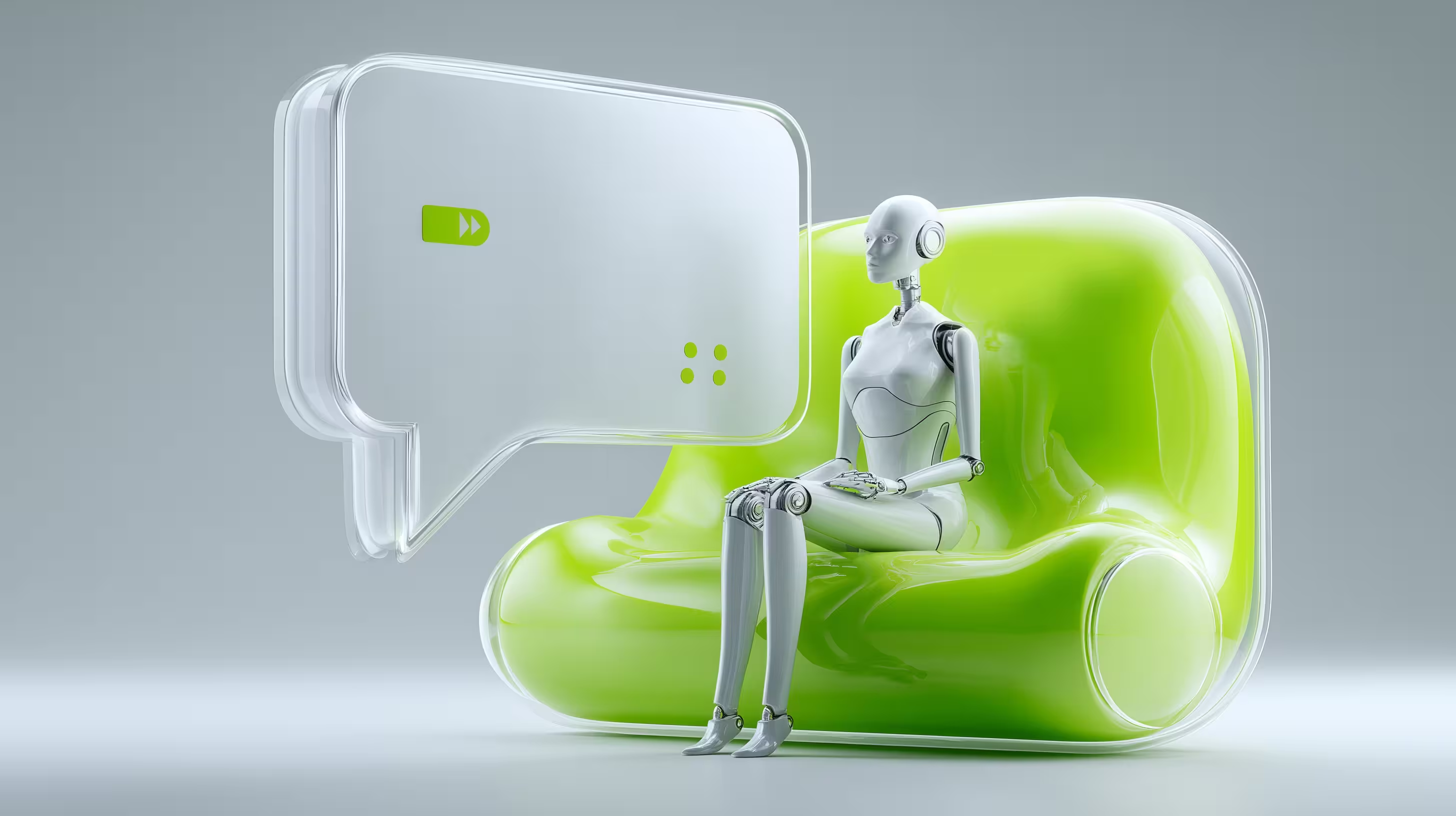Current technology's understanding of you goes beyond your online behaviour and interests for marketing purposes. Conversational UX design brings us closer to a not-so-futuristic reality as it creates seamless and engaging interactions between users and technology.
As artificial intelligence keeps its spot as a hot topic of the day and continues to give us a different perspective on the way we interact with technology, establishing key principles and staying up to date with the conversational UX design process is not to be missed by any professional in the field. This is why, we'd like to dive deeper into the key points we must keep in mind to keep our designs as accurate as possible to new technologies in conversational UX design.
Conversational UX: The Intersection of AI and Human Interaction
Remember the times when you had to click buttons or type commands to interact with technology? Well, those days are soon to be history! Conversational UX is the new cool kid in town. It's all about having a casual chat with technology, thanks to the wonder combo of AI and human interaction. This approach has found its way into everything, from virtual assistants like Amazon Alexa and Siri, to chat windows on shopping websites. It's like having a natural human conversation with your gadgets. And of course, that serves as a great tool to gain more insight from a UX designer's perspective.
Developing a seamless conversational experience requires a combination of elements which may include:
- A conversational user interface, like chatbots and voice assistants, simplifies user flow;
- Natural Language Processing (NLP), is crucial in interpreting and generating human-like responses in conversational UX;
- Voice User Interface (VUI) design, has evolved to create more engaging and efficient voice-based interactions.
Conversational Interface
Conversational interfaces, such as chatbots and voice assistants, offer users an instinctive method of interacting with software and bots. These conversational user interfaces are designed to understand and respond to user inputs in a way that simulates human conversation, making it harder to recognize AI agents compared to live agents. By making it easy for users to communicate with technology, conversational interfaces are revolutionizing customer communication and better customer experiences.

Natural Language Processing (NLP)
Natural Language Processing (NLP) is the fundamental technology behind every effective conversational UX. It uses machine learning and allows conversational interfaces to understand the user's intent and to fine-tune their tone properly. Based on our expertise, when considering the context of the conversation, assistants powered by NLP can produce more engaging and relevant interactions with customers.
This technology is essential for comprehending and generating natural conversation which leads to boosting the conversational experience.
Voice User Interface (VUI) Design
Voice User Interface (VUI) design has come a long way in recent years. Improved AI and NLP technologies, better speech recognition, and the potential for more natural and conversational interactions between users and web apps have all contributed to the evolution of voice user interface design.
As a result, voice assistants like Siri and Alexa have become increasingly capable of understanding and responding to user inputs in a way that feels more natural and engaging, enhancing the overall user experience with voice assistant technology.
Users can customize their own conversational experiences by altering the voice of their virtual assistants. For instance, Google Assistant allows users to choose between different accents and genders, while Siri offers a variety of voice options, including male and female voices in different languages.
Designing Conversational Flows for Maximum Efficiency

The design of conversational flows is often one of the main ingredients for crafting a productive conversational UX. It involves understanding user goals and designing interactions that help users achieve them efficiently.
Creating engaging conversational flows requires considering several factors.
- Mapping out user goals and designing conversations around those goals ensures that users can accomplish their objectives quickly.
- Balancing the AI and human elements in the conversation creates a more seamless and engaging experience.
- Incorporating visual cues in the interface helps to complement voice and text interactions, providing a more immersive user experience.
Mapping Out User Goals
Identifying user goals is the first step in designing conversational flows that cater to their needs. By understanding what users want to achieve, we can create interactions that help them reach their goals quickly and effectively and nurture their loyalty to a brand. This involves conducting user research, creating empathy and journey maps, and developing user personas based on their goals and preferences.
Visualizing the user’s journey towards their goal enables us, in the design field to craft conversational flows that offer an uninterrupted and efficient experience.
Balancing AI and Human Elements
Maintaining a balance between AI and real-person elements helps create a seamless and captivating conversation flow. AI-powered conversational interfaces should complement and augment human capabilities rather than replace them. By incorporating human-like behaviour, natural language processing, and empathy in the conversation, we, the UX creators can develop interfaces that sound more natural and engage users in a way that mimics human interaction.
This allows users to feel at ease and supported throughout the dialogue, resulting in a more satisfying conversational user experience.
Enhancing Interaction with Visual Cues
Visual cues, such as font weights, icons, colours, buttons and progress indicators are necessary for enhancing user interactions with conversational interfaces. These elements help guide users through the conversational user interfaces.
By incorporating these visual cues into a chatbot design, UX professionals and agencies like us, can create a more engaging and intuitive experience for users, complementing voice and text interactions, and ultimately leading to more effective and satisfying conversations.
Creating a chatbot persona

Creating a chatbot persona is the extra mile you might have to go to enhance the UX design process. A persona helps to humanize the chatbot and makes the interaction more engaging for users. The persona should be designed to align with your brand's voice and tone, and the needs of your target audience.
This persona will guide the language, tone, and style of conversation the chatbot will have with users. It's not just about making the bot sound human; it's about maintaining a consistent branding and believable personality that can build strong relationships with users.
Virtual assistants like Siri and Alexa have been humanized to a great extent, making interactions with them feel more like conversations with a real person. Their ability to understand and respond to natural language, coupled with their distinct personalities, contribute to a more engaging and relatable user experience. This humanization is key to their widespread acceptance and success in the world of conversational UX.
Conversational UI Best Practices for Customer Satisfaction

In our daily UX design practice, we should adhere to a set of best practices to create a successful conversational UI that caters to customer needs. These practices include personalization, continuous learning and adaptation, and accessibility and inclusivity in conversation design. By adhering to these best practices, those of us involved in design can ensure that our conversational interfaces deliver a satisfying and engaging user experience.
Adopting these best practices in conversational UI design not only enriches the user experience but also aids businesses in achieving a variety of goals, including:
- Increasing customer satisfaction
- Building customer loyalty
- Improving customer retention
- Boosting sales
By streamlining interactions between customers and businesses, conversational UI has become an essential tool across various industries, changing the way communications are conducted.
Personalization and Context Awareness
Tailoring conversations to user context and preferences is crucial for crafting a more engaging and satisfying user experience. By taking into account factors like the user’s past interactions, location, and preferences, businesses can offer more relevant and useful responses. Using a well-defined user persona can significantly boost the user experience in conversational UX. A persona, embodying the characteristics of your target audience, can help in crafting more personalized and relevant interactions, thereby enhancing user engagement and satisfaction. This makes the conversation feel more natural and helps users feel more understood and valued.
Many businesses now use Facebook Messenger as a platform for their chatbots. This allows for real-time, personalized customer service right where customers already spend their time. Users can ask questions, receive support, and even place orders directly through Messenger, making the user experience seamless and convenient. As a result, businesses can improve customer satisfaction and engagement, while also driving sales and growth.
Continuous Learning and Adaptation
The design of Conversational UX should accommodate continual learning and adaptation. By gathering user feedback and data, we can iteratively improve the conversational interface and ensure that it evolves to meet the changing needs and expectations of users. This involves monitoring and analyzing user behaviour and preferences, conducting user research, and refining the design based on user feedback.

Machine learning or teaching computers adds up to conversational UX, enabling the system to learn from past interactions and improve over time. Just like us, UX designers, machine learning algorithms can enhance the system's ability to respond effectively and provide a more personalized user experience. After all, analyzing patterns and trends in user behaviour is one of the key UX mapping techniques we use daily.
Accessibility and Inclusivity in Conversations
It’s important to design conversational interfaces with a focus on accessibility and inclusivity to cater to users with disabilities and diverse language skills. By considering the needs of all users, we can create conversational interfaces that are more accommodating and user-friendly. This includes:
- Integrating voice-enabled interfaces
- Designing conversations for different contexts
- Considering accessibility in the design of conversational AI systems
By prioritizing accessibility and inclusivity, we in the design field can create conversational UX that is more effective and engaging for all users.
Implementing Conversational UX Across Various Industries
Conversational UX is influencing various industries, including retail, healthcare, and education. Businesses are increasingly recognizing the value of conversational interfaces in streamlining customer interactions, providing personalized recommendations, and offering real-time support. By implementing conversational UX, companies can enhance customer satisfaction, boost user engagement, and gain a competitive edge in their respective markets.
The potential of conversational UX goes beyond just customer support and engagement. It has the power to transform industries by improving organizational efficiency, enabling more personalized interactions, and offering instant support to users. The subsequent sections will examine how conversational UX is being applied and making an impact in the retail, healthcare, and education sectors.

Retail: From Shop Assistants to Virtual Agents
In the retail industry, virtual agents are replacing the traditional shop assistant, offering personalized recommendations and support to customers. The use of AI-driven chatbots and voice assistants enables businesses to handle a large volume of customer inquiries efficiently, resulting in cost savings and improved customer satisfaction.
For example, KLM offers customers their boarding pass, booking confirmation, check-in details, and flight status updates through Facebook Messenger, showcasing the potential of conversational UX in customer support and engagement.
Healthcare: Conversational User Interfaces for Patient Support
In the healthcare sector, conversational interfaces are increasingly being utilized to:
- Provide patient support
- Simplify communication between patients and providers
- Offer more accessible healthcare data
- Help spot symptoms earlier
- Turn big data into useful insights
Conversational UX is revolutionizing the way healthcare services are delivered.
It is also making it easier for patients to book appointments and receive tailored treatment plans, ultimately leading to improved patient outcomes.
Education: Interactive Learning Through Conversational Design
Conversational design is transforming the educational sector by enabling interactive learning experiences and enhancing student engagement. Some examples of AI-driven conversational interfaces in education include:
- AI tutors that provide personalized interactions and instant support to students
- Automated grading systems that provide timely feedback to students
- User-friendly interfaces that make learning more accessible and engaging
These advancements in conversational design are empowering students and revolutionizing the way education is delivered.
By implementing conversational UX in educational platforms, educators can create more engaging and effective learning experiences for students, improving their overall educational outcomes.
Overcoming Challenges in Conversational UX Design

Despite the numerous benefits of conversational UX design, it also presents a fair share of challenges. We, as designers must address technical issues, create helpful error messages, and ensure privacy and security to create a seamless conversational experience. By tackling these challenges head-on, we can create conversational interfaces that not only meet user expectations but also deliver an engaging and satisfying user experience.
We can utilize a range of strategies and solutions to overcome these challenges for our clients. These may include:
- Gathering consumer feedback and data to continuously learn and adapt the conversational interface
- Employing best practices for creating informational messages that guide users through potential issues
- Prioritizing user privacy and security throughout the design process
Dealing with Technical Issues and Limitations
Resolving technical limitations and issues is key to creating a smooth conversational experience. This may involve tackling problems such as unnatural-sounding language, difficulty in providing the right conversational context and handling complex processes.
Drawing on our insights, designers can effectively address these challenges by:
- Continuously Iterating and Testing Conversational Interfaces: Emphasize the importance of an iterative approach to design, where constant refinement and testing of human-computer interaction are key. This method ensures that the interface evolves to meet user needs and expectations effectively, based on our observations.
- Collaborating with Other Stakeholders: Our collaborative efforts have shown that involving various stakeholders in the design process is crucial. This not only brings diverse perspectives to the table but also fosters a holistic understanding of user requirements and business goals.
- Staying Up to Date with Trends and Advancements in Conversational UX Design: In our field, staying informed about the latest trends and advancements in conversational UX design is essential. Our experience highlights that this proactive approach helps designers integrate cutting-edge elements into their work, ensuring that their designs remain relevant and innovative.
Creating Error Messages That Help Users Navigate
For any conversational UX, it’s important to design informational messages that guide users through the conversation and assist them in navigating potential issues. Best practices for crafting error messages include avoiding condescending language or blaming the user, making messages clear and understandable, and providing helpful guidance on how to fix the mistake.
By crafting messages that effectively communicate issues and guide users towards a resolution, we can improve the overall user experience and ensure that users feel supported throughout the conversation.
Ensuring Privacy and Security in Conversations
Privacy and security hold the utmost importance in conversational UX design. Those of us involved in design must prioritize user data protection and maintain trust throughout the conversation. This can be achieved by following GDPR, ensuring that data is stored, processed, and protected in compliance with these guidelines, and by implementing encryption techniques to secure messages sent and received between users and conversational interfaces.
By putting privacy and security at the forefront of conversational UX design, we can create interfaces that users can trust and rely on.
Frequently Asked Questions
What is conversational UI design?
Conversational UI is an interactive technology replicating conversations between a user and a computer, making it easier to navigate through digital systems. It is the modern take on user interfaces, making it simpler and more efficient for users.
What is the conversational UX design process?
Conversational UX design is the process of planning the dialogue between a consumer and a computer-generated partner. It involves incorporating technologies like voice, chat, gestures or any other natural language-based technology to mimic a human conversation.
How does natural language processing (NLP) contribute to conversational UX?
NLP is essential for conversational UX, allowing systems to understand customer intent and respond appropriately. It provides a more natural dialogue between customers and products, helping create a smoother overall user experience.






